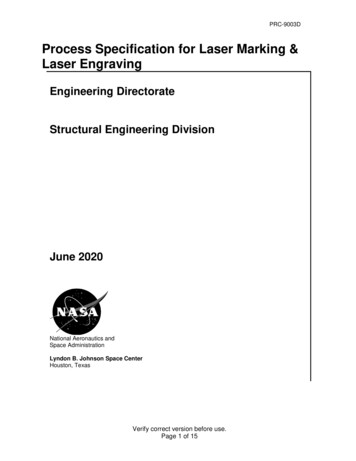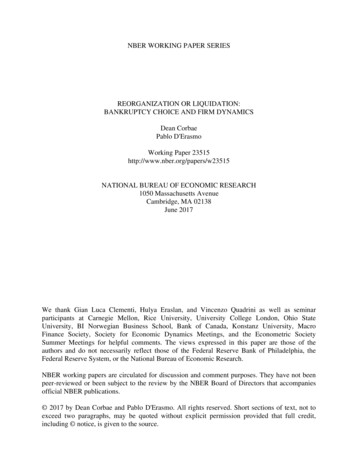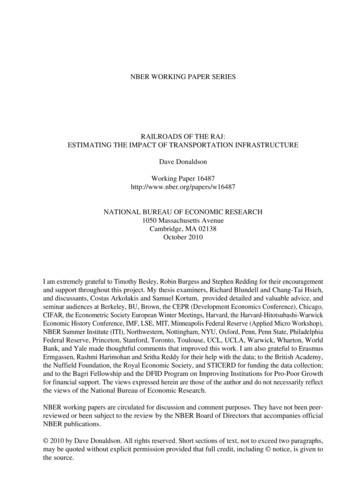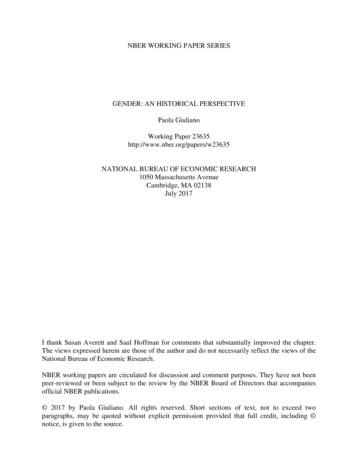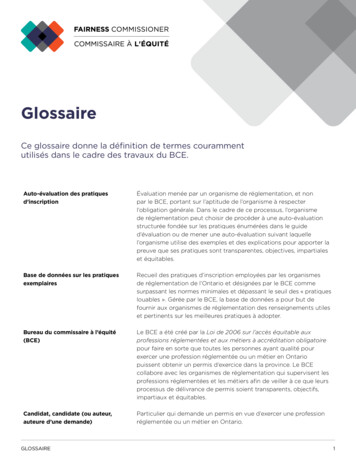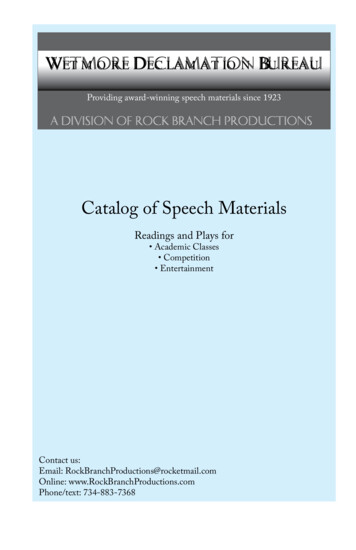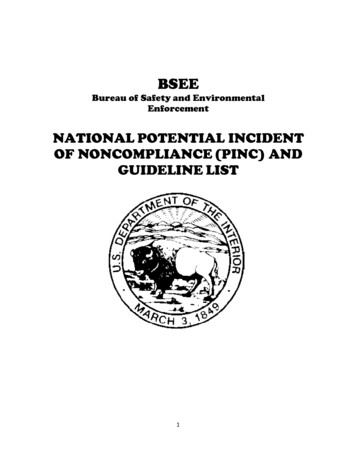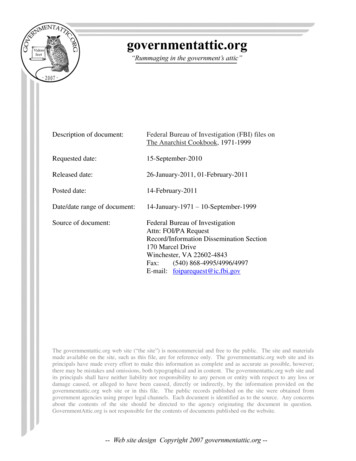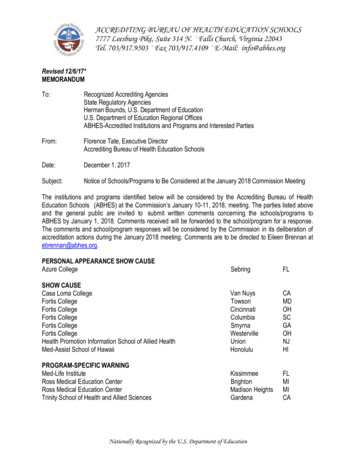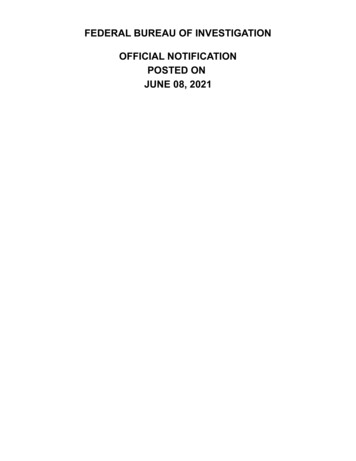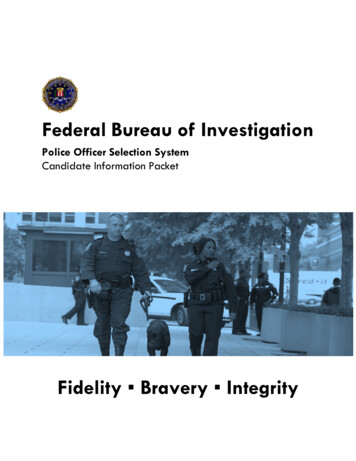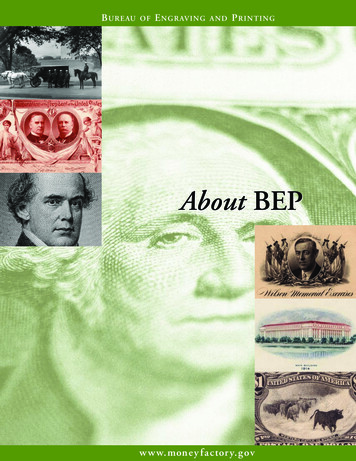
Transcription
B u r eauofe n g ravingan dP rint in gAbout BEPw w w. mon e y f ac tor y. g ov
TABLE OF CONTENTSINTrOduCTION . . . . . . . . . . . . . . . . . . . . . . . . . . . . . . . . . . . . . . .2HISTOry . . . . . . . . . . . . . . . . . . . . . . . . . . . . . . . . . . . . . . . . . . . .2PrINTINg BurEAu PrOduCTS . . . . . . . . . . . . . . . . . . . . . . . . . . . .4Designengraving . . . . . . . . . . . . . . . . . . . . . . . . . . . . . . . . .4Plate-making . . . . . . . . . . . . . . . . . . . . . . . . . . . . . . . . . . . . . . . .4Printing . . . . . . . . . . . . . . . . . . . . . . . . . . . . . . . . . . . . . . . . . . .5CurrenCy examination, overPrinting,PaCkaging . . . . . . . . . . . . .5COuNTErFEITINg, rEPrOduCTION, ANd . . . . . . . . . . . . . . . . . . . .ANTI-COuNTErFEITINg MEASurES6MuTILATEd ANd dAMAgEd CurrENCy . . . . . . . . . . . . . . . . . . . . . .7TOurS . . . . . . . . . . . . . . . . . . . . . . . . . . . . . . . . . . . . . . . . . . . . .8PuBLIC SALES . . . . . . . . . . . . . . . . . . . . . . . . . . . . . . . . . . . . . . . .8anDanD
INTrOduCTIONThe Department of the Treasury’s Bureau of Engraving and Printing(BEP), serves as the Federal Government’s most secure and efficientsource of vital Government securities.The Bureau designs and produces a variety of security products. As theGovernment’s only source for paper currency production, the Bureauprints billions of Federal Reserve Notes for delivery to the FederalReserve System each year (the Bureau does not produce coins; allcoinage is produced by the United States Mint). In addition, theBureau produces military commissions and award certificates; invitationsand admission cards; and many different types of identification cards,forms, and other special security documents for a variety of Governmentagencies. With production facilities in Washington, DC, and Fort Worth,Texas, the Bureau is the largest producer of Government securitydocuments in the United States.The Bureau’s research and development efforts focus on the continueduse of automation in the production process and on counterfeit deterrenttechnologies for use in security documents, especially U.S. currency. TheBureau also advises other Federal agencies on document security matters.HISTOryInvitation to attend inauguralceremonies for the President of theunited States, 1917 (plate proof)Member’s Pass to the Visitor’sgallery, House of representatives,1898 (approved plate proof)Cattlehide Export Ticket for 1,000,Bureau of International Commerce,Office of Export Control, departmentof Commerce, about 1972The Bureau of Engraving and Printing has its origins in legislationenacted to help fund the Civil War. In July 1861, Congress authorizedthe Secretary of the Treasury to issue paper currency in lieu of coin dueto the lack of funds needed to support the conflict. The paper noteswere essentially Government IOUs and were called Demand Notesbecause they were payable “on demand” in coin at certain Treasuryfacilities. At this time the Government had no facility for theproduction of paper money so a private firm produced the DemandNotes in sheets of four. These sheets were then sent to the TreasuryDepartment where dozens of clerks signed the notes and scores of femaleworkers cut the sheets and trimmed the notes by hand. Gradually, moreand more work involving currency and Government obligations(bonds, notes and etc.), including their engraving and printing, devolvedto the Treasury.Initially, the currency processing operations in the Treasury were notformally organized. When Congress created the office of Comptrollerof the Currency and National Currency Bureau in 1863 to handle thenewly created National Bank Notes, currency-processing operations2B u reauofe ng r avi nga ndP r in ting
were nominally subordinated to that agency and designated the “FirstDivision, National Currency Bureau.” For years, however, the currencyoperations were known by various semi-official labels, such as the“Printing Bureau,” “Small Note Bureau,” “Currency Department,”and “Small Note Room.” It was not until 1874 that the “Bureau ofEngraving and Printing” was officially recognized in congressionallegislation with a specific allocation of operating funds for fiscalyear 1875.In 1877, Congress mandated that the engraving and printing of notes,bonds, and other securities of the United States be performed solely atthe Treasury Department. Up until that time, the Bureau incombination with private bank note companies produced variouscurrency notes that included National Bank Notes and United StatesNotes. Other currency produced exclusively by the Bureau includedGold Certificates, Silver Certificates, and Treasury (or Coin) Notes.Federal Reserve Notes, originally issued in 1914, are the only currencynotes still being issued today. In addition to U.S. currency, the Bureauhas designed or produced, in whole or part, currency for the Philippines,the Republic of Cuba, South Korea, the Kingdom of Siam, and Eritrea.Throughout the course of its operations, the Bureau has designed andprinted a variety of products in addition to currency. Other early itemsproduced by the Bureau included various Government debt instrumentssuch as interest-bearing notes, refunding certificates, compound interestTreasury notes, and bonds. In 1866, the Bureau began printing internalrevenue stamps and, by 1878, it was producing almost all revenuestamps. Postage stamp production began in 1894. The Bureau has alsoproduced invitations for Presidential inaugural ceremonies and memorialservices as well as other souvenir items commemorating various eventsand expositions. During times of crisis the Bureau has printed specialproducts that have included military payment certificates for Americanarmed forces, currency and postage stamps for a number of Alliedcountries, and war bonds.The first home of the Bureau was at the Treasury Department at 1500Pennsylvania Avenue, where from 1861 to 1880 work was conductedprimarily in the basement and attic of that building. In 1878, due toconcerns over safety as well as the disruption the Bureau’s industrialoperations brought to other offices within the Treasury Building,Congress appropriated funds for construction of a separate building.A section of land on the southwest corner of 14th Street and B Street(now Independence Avenue) was purchased that same year, andconstruction of the first Bureau building was completed in 1880. By1906, the Bureau had outgrown this facility and the decision was madeto construct a building between 14th and 15th Streets, to the southa Bo u t BeP 1 Silver Certificate, Series 1899, face(approved model with annotations)Currency examination, 1904Vignette of 1880 Bureau of Engravingand Printing Building, 1901 (approvedplate proof)
of the original building. The new structure, now known as the Mainbuilding of the Bureau of Engraving and Printing, was completed inFebruary 1914.By the mid 1920s, the need for another facility became apparent duein part to large Bureau production requirements related to World War Ifinancing operations. In August 1935, Congress granted funds for abuilding on 14th Street between C and D Streets, opposite the Mainbuilding. Construction of the Bureau’s Annex building was completedin 1938. In 1985, the Bureau began a site search for an operatingfacility west of the Mississippi River that would meet increased currencyproduction needs and act as a contingency operation in case ofemergencies in the Washington, DC, metropolitan area. In November1986, Fort Worth, Texas, was chosen to host the Bureau of Engravingand Printing’s Western Currency Facility (WCF). Currency productionbegan in December 1990 at the WCF, and the official dedication tookplace on April 26, 1991.PrINTINg BurEAu PrOduCTSDesignBureau of Engraving and Printing,Annex building, 19 9Western Currency Facility,circa 1987–1991Charles r . Chickering, designer,early 1950sanDengravingPrint production begins with the skill and artistry of the Bureau’sdesigners and engravers. Designers create a model of the printed productby combining images, text, and other graphic elements into a visuallypleasing format. When products incorporate engraved elements — suchas a portrait, vignette, ornament, or lettering — the Bureau’s engravers,working from the designer’s model, create these components of thedesign. By meticulously cutting extremely fine dots, dashes, and curvedlines of varying depths and widths into a piece of soft steel, known as amaster die, the engraver produces a very life-like and three-dimensionalimage on a two-dimensional surface. The art of engraving not onlybrings a unique beauty to the Bureau’s printed products but also servesa more pragmatic function as an anti-counterfeiting measure. Whileit is the complexity of engraved lines that give such products a visualrichness, it is also this technique that makes them extremely difficultto replicate.Plate-makingWhen the artwork or engraved master dies are completed and approved,depending on the method of printing, they are then converted into anappropriate format for reproduction. Utilizing various technologies,multiple images of the originals are created and transferred to the master4B u reauofe ng r avi nga ndP r in ting
Currency plate inspectionPrinting currency on a four-plate flat bed power press, late 1940sHarris two-color offset press, 1940sCurrency processingprinting plates. From the master plates, working plates are created.From the working plates, the final printed products are generated.PrintingThe Bureau utilizes a number of different printing methods forproducing its various products. These include intaglio, gravure, andoffset.In the intaglio process ink is applied to an engraved plate that is wipedclean leaving ink in the recessed lines or grooves. The inked plate ispressed against a sheet of paper using heavy pressure, forcing the paperinto the grooves of the plate, picking up the ink, and transferringthe engraved image onto the paper. The printed surface feels slightlyraised, while the reverse side feels slightly indented. Gravure printingconsists of a pattern of tiny etched dots on the printing plate; ink heldinside the tiny dots is lifted up when paper is pressed against the plate,as in the intaglio method. In offset production, the image is lifted offthe printing plate onto a rubber blanket by means of chemicalattraction/repulsion and then transferred or offset to the paper.Until recently, intaglio was the primary method used by the Bureau forprinting currency. However, with the introduction of subtle backgroundcolor to Series 2004 notes, a combination of intaglio and offset isemployed. Intaglio is used to print the engraved portions of the noteand offset is used to print the background color.CurrenCy examination, overPrinting,anDPaCkagingEach printed currency sheet containing multiple impressions of notesis examined for defects. If the sheet meets the electronic inspectionstandards, it is then ready for numbering and processing. Using theBureau’s overprinting and processing equipment, the Federal ReserveSeal, the Treasury Seal, and serial numbers are added to each note.Stacks of 100 sheets are ultimately cut into one-note units and thenbanded and packaged into bricks of 40 units (or 4,000 notes). Thebricks are distributed to one of the 12 Federal Reserve banks, whichissues the notes to local banks.a Bo u t BeP5
COuNTErFEITINg,rEPrOduCTION, ANd ANTICOuNTErFEITINg MEASurESThe law sharply restricts reproductions of paper currency as well as othersecurity documents of the United States. The following actions are inviolation of Title 18 of the United States Code: Manufacturing counterfeit United States currency or alteringgenuine currency to increase its value; Possession of counterfeit United States obligations with fraudulentintent; Forging, altering, or trafficking in United States Government checks,bonds, or other obligations; Defacement of currency (generally defined as: Whoever mutilates,cuts, disfigures, perforates, unites or cements together, or does anyother thing to any bank bill, draft, note, or other evidence of debtissued by any national banking association, Federal Reserve bank, orFederal Reserve System, with intent to render such item(s) unfit tobe reissued); Making or distributing business cards, notices, or advertisements inthe likeness of United States obligations or securities.Printed reproductions, including photographs, of paper currency andother securities of the United States and foreign governments are alsoviolations of Title 18 of the United States Code, except under thefollowing conditions:Currency plates, master die, andtransfer roll The illustration must be of a size less than three-fourths or morethan one and one-half, in linear dimension, of each part of anymatter so illustrated; The illustration must be one sided; All negatives, plates, digitized storage media, graphic files, magneticmedia, optical storage devices, and any other thing used in themaking of the illustration that contain an image of the illustrationor any part thereof shall be destroyed and/or deleted or erased aftertheir final use.The Secret Service has jurisdiction over investigations involving thecounterfeiting of United States securities and works closely with state,local, and foreign law enforcement agencies to aggressively pursuecounterfeiters. The Secret Service also maintains a working relationship6B u reauofe ng r avi nga ndP r in ting
with the Bureau of Engraving and Printing and the Federal ReserveSystem to ensure the integrity of our currency.The Bureau is responsible for producing currency that incorporatescounterfeit deterrents. Microprinting (fine lettering that is invisible tothe naked eye but readable using low-power magnification and difficultto reproduce on most current copiers) and a translucent security threadwere first added to currency in 1991. Later, Series 1996 currency alsoincorporated color-shifting ink that changes color when viewed fromdifferent angles; a watermark; fine-line printing patterns that appearnormal to the unaided eye but are difficult for copiers and scannersto replicate; and additional security features to address counterfeitingthreats posed by advances in color reproduction equipment and processes.With Series 2004 currency, subtle background colors were introduced,adding complexity to the design and making the note more difficultto counterfeit.MuTILATEd ANd dAMAgEdCurrENCyThe Bureau of Engraving and Printing redeems partially destroyed orbadly damaged currency as a free public service. The Office of CurrencyStandards uses experts to examine mutilated currency and approve theissuance of a Treasury check for the value of the currency determined tobe redeemable. The amount of time needed to process currency claimsvaries with the extent of the damage and the workload of the examiner.What is mutilated currency? Currency notes which are clearly less thanone-half of the original note and/or in such condition that the value isquestionable and special examination is required to determine its value.The most common causes of currency mutilation are fire; water;chemicals; explosives; animal, insect or rodent damage; and petrificationor deterioration by burying. Mutilated currency may be mailed orpersonally delivered to the Bureau of Engraving and Printing and shouldinclude a letter stating the estimated value of the currency and anexplanation of how the currency became mutilated.What is not mutilated currency? Any badly soiled, dirty, defaced,disintegrated, limp, torn, or worn-out currency note that is clearly morethan one-half of the original note, and does not require specialexamination to determine its value. These notes should be exchangedthrough your local bank.a Bo u t BeP7Examples of mutilated and damagedcurrency
TOurSTours of Bureau facilities feature the various steps of currencyproduction beginning with large blank sheets of paper and ending withwallet-ready bills. Current information about tours may be obtainedfrom the Bureau’s website (www.moneyfactory.gov) or by telephoningthe Bureau at 1-866-874-2330 for Washington, DC, tours and1-866-865-1194 for Fort Worth, Texas, tours.PuBLIC SALESThe Bureau of Engraving and Printing also offers a number of premiumproducts for sale. These include vignettes of historic monuments andsites, Presidential and Chief Justice portraits, as well as note cardsfeaturing the engraved images of some of the Nation’s most popularlandmarks: the Capitol, the Department of the Treasury, the WhiteHouse, and the Lincoln and Jefferson Memorials. Uncut sheets ofcurrency, star notes, commemorative posters and more, as well assouvenir cards featuring reprints of exquisite, collectible historic andantique engravings are also available. Products may be purchased onlineat the Bureau’s website (www.moneyfactory.gov), in person at a BureauVisitor Center, or by telephoning the Bureau at 1-800-456-3408.(Please note that the Bureau of Engraving and Printing does not sell oldor rare currencies or other security items. The Bureau cannot offerappraisals regarding the value of such items.)Currency processingMulti-subject currency plateVignette of the Lincoln Memorial8B u reauofe ng r avi nga ndP r in ting
Cover imagesBureau of engraving and Printing horse-drawn wagon taking money to the Treasury,about 1910admission card to inauguration of William mcKinley, 1897 (approved plate proof)salmon P. Chase, 1873 (die proof)admission ticket to Woodrow Wilson memorial exercise, 1924 (approved plate proof)vignette of the Bureau of engraving and Printing, main building, 1950s/1960sPostage stamp “Western Cattle in storm,” Trans-mississippi exposition/“omaha”series, 1898
depa rtm en t of t he tr ea su ryw w w.mon ey f a c tor y. g ov
Pennsylvania Avenue, where from 1861 to 1880 work was conducted primarily in the basement and attic of that building. In 1878, due to . other thing to any bank bill, draft, note, or other evidence of debt issued by any national banki
